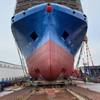Sustained strong oil demand growth is required to lift product tanker freight rates out of their current depressed levels, shipbroker Simpson Spence & Young said in a new report.
Temporary seasonal surges could be seen in rates but it would take until the northern hemisphere winter of 2000-2001 before the sector experienced a sustained rise in earnings, SSY said in its latest half yearly World Oil tanker Trends report. "The only factor that can lift the product trade out of the gloom is sustained and strong oil demand growth," SS&Y reported.
Positive signs were seen in current global oil demand, SS&Y said, but a bloated vessel orderbook precluded near term recovery.
A total orderbook of 136 ships of 6.3 million dwt included 59 vessels, totaling 2.5 million dwt, due to be delivered in the second half of 1999.
Chemical tankers seeking respite from their own depressed market and high order levels could switch into the oil products trade further increasing supply over capacity.
Plans by India to double its refining capacity by 2002 to 2.6 million bpd could mean the virtual elimination of the products trade to the country causing problems for Middle East export-oriented refineries, SS&Y said.
They would have to seek new markets in East Africa and the Atlantic basin.
Increased cross-Pacific trade to the U.S. West Coast was also expected to meet proposed new Californian gasoline regulations.
VLCC Rates To Stagnate
The SS&Y report said that large tanker rates will stagnate over the next 12 months around the depressed levels set in 1999.
Freight rates will be held down as deliveries from a large outstanding orderbook exceed ship scrappings and crude output cutbacks ensured a continued shipping overcapacity.
"Earnings seem poised to stagnate at 1999 levels until a partial revival in 2001," SS&Y said.
Modern VLCCs could expect to earn between $20-22,000 a day in the second half of the year, and older vessels $16-18,000 although that could be squeezed by high bunker oil prices. Average VLCC earnings were above $30,000 a day last year.
"Even if 75 percent of (OPEC) cutbacks are implemented, an adverse impact on tanker markets is a foregone conclusion," SSY said of prospects that rising oil prices could lead to increased production.
VLCC scrapping reached 4.0 million dwt in the first half with a further 2.8 million dwt sold for demolition, but new VLCC deliveries totaling 5.9 million dwt are expected in the second half of 1999 after 4.1 million dwt in the first six months.
Suezmax tankers were likely to be affected by similar factors with earnings declining by five percent in 1999 and stagnating next year, SS&Y said.
The million barrel market could also be affected by stricter European implementation of safety regulations which could drive older non segregated ballast tank vessels out of the Mediterranean.
This could benefit Aframax vessels in the area, but overall they were also set for a turbulent period.
"Aframax owners look set for a rough ride in the next two years, as lower output from traditional lifting areas reduces tonnage demand and a massive newbuilding program leads to a tonnage surplus," SS&Y said.
Featured videos

Inmarsat Enhances Service to Drive Digitalization

Unlock Onboard Data Efficiencies

Tracking Foreign Vessels Working in the U.S. Jones Act Market
Subscribe for
Maritime Reporter E-News
Maritime Reporter E-News is the maritime industry's largest circulation and most authoritative ENews Service, delivered to your Email five times per week









